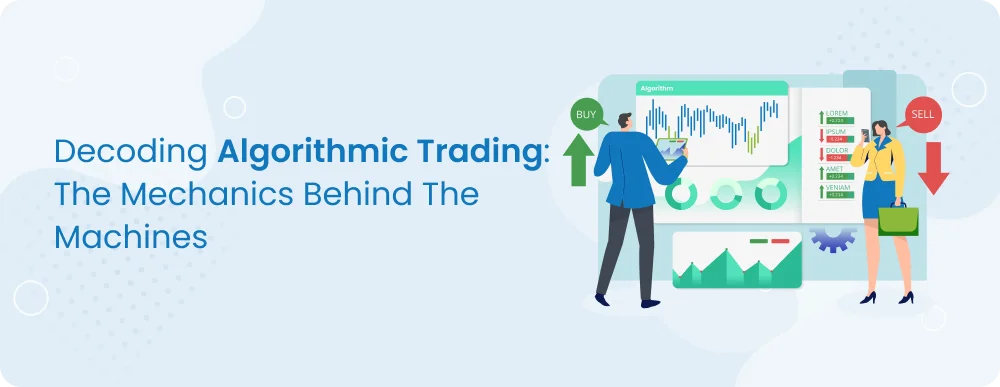Decoding Algorithmic Trading: The Mechanics Behind the Machines
Noor Kaur
28 Jan 2025Tags:
Featured
Algorithmic trading (algo trading) uses computer algorithms to execute trading strategies at high speeds. This automated process uses mathematical models to identify optimal buy or sell opportunities in financial markets. Automated trading eliminates human intervention, enhancing efficiency and consistency.
In this article, we’ll explore the key components and advantages of algorithmic trading and explain how it works in modern stock markets.
What is Algorithmic Trading?
Algorithmic trading uses computer algorithms (pre-set rules or instructions) to automatically execute trades in the financial markets. These algorithms analyse large amounts of market data, such as price movements and volume, to identify trading opportunities. Algo trading allows for faster and more efficient execution of trades, reducing the need for human intervention.
How Algorithmic Trading Works
Here’s how algorithmic trading works:
- Data Collection and Analysis: The first step in algorithmic trading is gathering and analysing data from various sources, like market prices, trends, and financial indicators. The algorithm uses this data to identify patterns and trading signals.
- Strategy Creation: Traders design strategies based on specific rules once data is collected. For instance, if a certain stock hits a particular price point, the algorithm automatically executes a buy or sell order. These strategies can include methods like trend following or scalping.
- Execution of Trades: The algorithm automatically places orders based on earlier conditions after a strategy is set. The automated trading system can make trades quickly, ensuring that no time is wasted and orders are executed at the best possible price.
Key Components of Algorithmic Trading
To understand algorithmic trading, it’s essential to know the key components that make it work. These elements allow algo trading systems to function efficiently, providing a systematic and automated approach to trading. Here are the core components:
1. Data Gathering and Analysis
Data is the foundation of algorithmic trading. Automated trading systems rely on vast amounts of historical and real-time data to identify patterns, trends, and market conditions. This data includes price movements, volume, and other market factors. By analysing this information, the system can make informed trading decisions.
2. Strategy Formulation
Once the data is collected, the next step in algorithmic trading is formulating a strategy. This strategy consists of specific rules and conditions based on data analysis. These rules guide the system on when to buy, sell, or hold an asset. The strategy can be tailored to your trading goals, whether you’re focused on scalping, trend following, or other methods.
3. Execution
After the strategy is set, automated trading systems execute trades automatically based on the predefined conditions. The system can place orders at high speeds without human intervention, ensuring precision and consistency in the trading process. This component allows the algorithm to operate in real-time, responding immediately to market changes.
Advantages and Challenges
Algorithmic trading offers various advantages but also comes with challenges. While it provides greater efficiency and accuracy, it's crucial to understand both sides to decide if it's the right approach for you. Here are the main benefits and challenges of algo trading:
1. Efficiency and Speed
Automated trading systems can execute trades much faster than humans. They process data in milliseconds, allowing you to take advantage of price movements quickly. This high speed is crucial for algorithmic trading, especially in fast-paced markets.
2. Real-time Execution
With algorithmic trading, trades are executed instantly when predefined conditions are met. This minimises the delay between identifying and acting on an opportunity, which is critical for algorithm stock trading.
3. Reduced Human Error
Since algo trading is automated, there’s less risk of mistakes caused by fatigue, emotional decisions, or missed opportunities. This results in more consistent and reliable trades.
4. Enhanced Accuracy and Consistency
Algorithmic trading systems use precise calculations to determine the best entry and exit points. This leads to higher accuracy and helps maintain consistency in your trading performance.
5. Removing Emotional Biases
Automated trading systems follow clear rules and remove emotional factors that could lead to poor decision-making. This helps avoid impulsive trades based on fear or greed, improving long-term outcomes.
6. Systematic Approach
With algorithmic trading, strategies are executed systematically according to a set plan. There’s no deviation from the predefined rules, which helps keep trading organised and disciplined.
7. Access to Diverse Strategies
Algo trading allows you to implement a range of strategies—whether it's for long-term investments or short-term trades. From scalping (making many small trades to capture small price changes) to trend following (trading based on market momentum), you have flexibility in approaching the market.
8. Scalping, Trend Following, and More
Using automated trading allows you to take advantage of various strategies like scalping or trend following, which can be difficult to manage manually. These strategies help capture profits from different market conditions.
9. Customisation Options
Algorithmic trading systems offer the ability to customise strategies to suit your needs. You can adjust parameters and backtest your approach to refine it and ensure it aligns with your investment goals.
The Evolution of Algorithmic Trading
Initially, institutional investors used algorithmic trading for large block trades. Over time, it evolved as faster computers, advanced data analysis, and high-frequency trading (HFT) became common.
Today, algo trading is accessible to retail traders as well, with platforms offering customisable algorithms for strategies like trend following and mean reversion. The rise of automated trading has increased market liquidity and reduced costs, making it a key tool in modern trading.
However, it also introduced new challenges like market volatility and the need for strict regulations.
Conclusion
Algo trading has revolutionised how traders interact with financial markets, offering enhanced speed, accuracy, and the ability to process vast amounts of data quickly. For algorithm stock trading or automated trading strategies, algorithmic trading allows traders to optimise their strategies while reducing emotional bias and human errors.
Noor Kaur
28 Jan 2025Related blogs


How the Stock Market Works in India: A Guide | mastertrust
Have you ever wondered about the complexities of the stock market in India? If so, you're not alone. In this exten...


Role of Inflation in Long-Term Investment Planning
In Financial Planning, one of the things that plays a key role is the impact of inflation on your investments.


Understanding FERA vs. FEMA: Key Differences Explained | mastertrust
In the world of financial services and international trade, regulations play a crucial role in governing transaction


Understanding Negative Rate Bonds: Investor Strategies | mastertrust
Bonds are considered a popular investment avenue by Investors. The demand for negative yield bonds is on the rise
Sign up to our newsletter !
Share this article on
Recent articles
Tags:
Open a Demat Account in just 15 minutes !

Click on open
account below

Fill out some
basic details

Upload your
documents

Start trading in
24 Hours *
Commonly asked questions
Is Master Capital Services Limited SEBI registered?
Do you have a mobile app for Trading and Finance Management?
What services does mastertrust provide?
What is the minimum investment required to start trading with your company?
Is my personal and financial information secure with your company?
What is your customer support availability?





